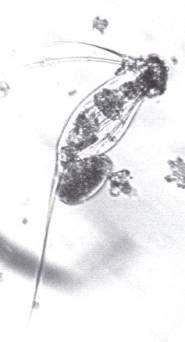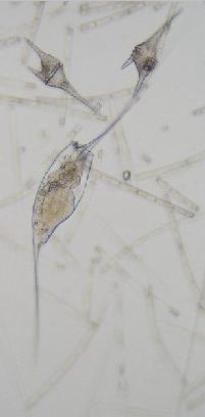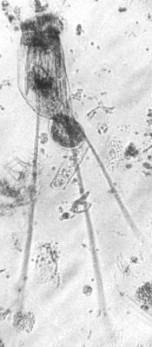FILINIIDAE, HARRING AND MEYERS, 1926 (family)
Without foot. Cuticle thin, transparent,
not usually retaining its shape well after
preservation. Body with long spines, 2 anterior
and 1 (Filinia) or 2 (Tetramastix) posterior
spines. Planktonic.
The separation in two genera (Filinia and
Tetramastix) based on the number of posterior
spines might not be valid since intermediates
are found (RuttnerKolisko 1972).FILINIA, BORY ST. VINCENT 1824.
The genus is abundance among the plankton in polluted
biotopes like Pasig River (2009a). Prefer alkaline
waters (Sládeček 1983).
TETRAMASTIX GROUP
Two posterior spines developed. One well developed
(200 μm) one more or less reduced (= spine).
Lateral spines broad-based, club-like, and
only slightly longer the body. Body spindle
shaped. Size 150-200 μm. Shows affinity for
cryptomonads, cyanobacteria (blue greens)
and dinoflagellates in Lake Lanao (Lewis 1979).
Warm stenotherm (25-38oC), pH 7.3-8.2,
conductivity 50-1,450 μS cm-1. Planktonic
in lakes and ponds. Indicator of oligotrophic
waters (Sládeček 1983). Stenohaline, cannot
handle a wide fluctuation in the salt content
of water. Common.
- Laguna de Bay, La Mesa Dam, Calibato Lake,
Lake Lanao, Paoay Lake.
Filinia opoliensis, (ZACHARIAS, 1898)
(syn. Tetramastix opoliensis)
[1941a, 1974, 1977, 1978a+b, 1979b,
1980, 1984a, 1986a, 2008b, 2011b+c]
F. opoliensis from Laguna de Bay
F. opoliensis
(Photo Rey Donne S. Papa, 2007)
71 b Only one posterior spine........................72
FILINIA-TERMINALIS GROUP
72 a. Only one movable posterior spine, arising from the ventral
surface. Spines not thickened at the base. Lateral spines
much longer than body, but less than 4 times than the body
length. Inserted more than 10 μm from terminal end of body.
Size of body 150-250 μm, lateral spines 300-710 μm, terminal
spine 125-315 μm. Lake forms usually with longer spines than
pond form. Form limnetica (or species Filinia limnetica
(ZACHARIAS 1893)) if spines 4 times longer than body or more.
Feed on detritus and bacteria, with a particle size less than
10 μm. Warm stenotherm 23-31oC, pH 7.4-8.1, and conductivity
180-1,600 μS cm-1, salinity 0-0.50/00 but stenohaline, so it
cannot handle a wide fluctuation in the salt content of water.
In shallow, eutrophic lakes, fishponds, village ponds. May
dominate the rotifer community. Indicator of eutrophic and
polytrophic waters (Sládeček (1983). Abundance was higher in
the Northern basin of Taal Lake, than the Southern basin,
probably caused by the eutrophication effect of the fish
gages in the area (Papa et al. 2011b).
- Laguna de Bay, Sampaloc Lake, Taal Lake.
Filinia longiseta (EHRENBERG, 1834)
(syn. Triarthra longiseta)
(syn. F. L. form limnetica
Filinia limnetica (ZACHARIAS 1893))
[1941a, 1974, 1980, 1984a, 1999, 2011b+c]
F. longiseta from Laguna de Bay
72 b. Small, cylindrical-oviform body, posterily
rounded but may be fusiform in contracted
individuals. Posterior spine inserted 4-10 μm
from terminal end of body, slightly thickened
at base. Like F. terminalis. Body length
120-140 μm. Lateral spines 265-350 μm.
Terminal spine 180-290 μm. In eutrophic
lakes and rice fields (Shiel and
Sanoamuang, 1993, Tuyor and Segers, 1999)
- IRRI rice field.
Filinia novaezealandiae, SHIEL AND SANOAMUANG, 1993
[1999]
72 c. Caudal seta inserted terminally, Body narrow-elongate fusiform.
Body relatively short, usually shorter than 200 μm.
Trophi with 16-17/17-19 unci.
- Laguna de Bay.
Filinia pejleri HUTCHINSON, 1964
[2012a]Other pantropic species of Filinia from the neighbourhoods
(se Sanoamuang, 2002):
Lateral setae inserted at the point near middle part of body.
- Not recorded from the Philippines.
Filinia camasecla MEYERS, 1938
Lateral setae short.
- Not recorded from the Philippines
Filinia brachiata (ROUSSELET, 1901)
To 73a


